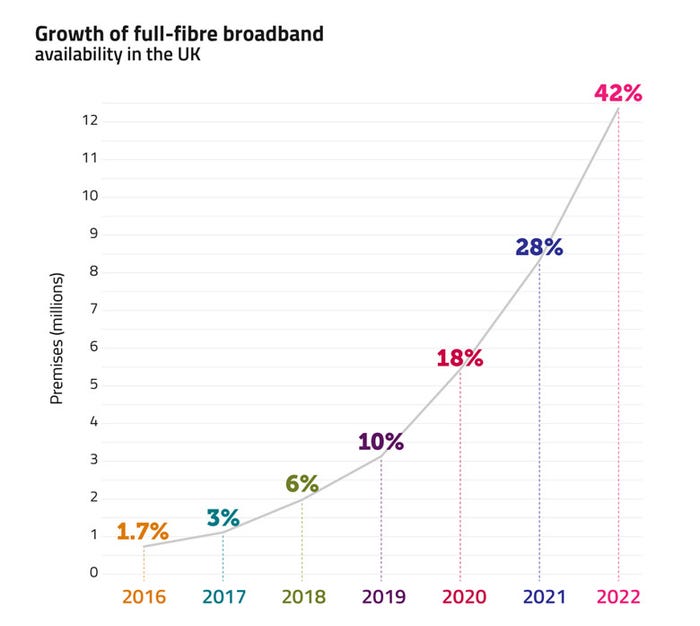UK fibre rollout is booming but take-up is lagging - Ofcom
The availability of full fibre broadband in the UK has grown rapidly over the past year, but convincing consumers to sign up remains a challenge, one that Ofcom has now taken up.
December 15, 2022

The availability of full fibre broadband in the UK has grown rapidly over the past year, but convincing consumers to sign up remains a challenge, one that Ofcom has now taken up.
The UK telecoms regulator published the 2022 edition of its annual Connected Nations report on Thursday, which showed that full fibre broadband now passes 42 percent of UK households, or around 12.4 million. That’s an increase of 4.3 million households over 12 months, the market’s biggest annual growth rate to date (see chart).

However, only a quarter of those 12.4 million households actually have fibre broadband. And while Ofcom is not really in the business of telling customers what services they do or do not need, it’s clear from its report that it is keen to increase that take-up rate.
“Customers who are out of contract could potentially upgrade to a discounted full fibre package without paying more than they currently do,” the regulator said.
In addition, it is using the increase in data consumption to further its cause. Households now use an average 482 GB of data per month, up 6 percent from 453 GB last year, and “full fibre can better support families who need to stream, work, game, video-call and study online all at the same time,” Ofcom insisted. Incidentally, the growth rate was similar last year, but both fall way behind the 2020 peak of a 30 percent year-on-year hike in data usage, driven by Covid-19, of course.
Ofcom is not exactly doing the telcos’ and ISPs’ marketing jobs for them on the fill fibre front, but it’s pretty obvious that it is trying to push adoption of the technology.
Its comments are all the more interesting given that this week Openreach submitted its Equinox 2 wholesale fibre-to-the-premises (FTTP) pricing plan to the regulator for its approval. The network operator’s rivals certainly do not approve, given that the scheme relies on long lock-in periods for retail ISP customers, which the altnets worry will stifle competition in the market. Ofcom itself hasn’t had anything to say on the matter yet, but will hold a consultation early next year. The extent to which it is keen to drive full fibre take-up will undoubtedly play a part in its decision-making though.
The Connected Nations report is not all about fibre though.
Ofcom’s data shows that 97 percent of UK homes now have access to superfast broadband, defined as a downstream connection of 30 Mbps or more. While 27 percent of those who can access superfast broadband have yet to take up such services, Ofcom doesn’t seem particularly keen to persuade them to do so.
It notes that the number of households in the UK without access to a decent broadband connection – that’s 10 Mbps downlink and 1 Mbps up – has fallen to 80,000 (or 0.3 percent) from 123.000 last year. A further 15,000 will be covered by publicly-funded schemes in the next 12 months, it predicts, bringing that number down further.
The regulator also nods to satellite as a credible fixed broadband alternative, noting that “thousands” of UK customers have signed up for low earth orbit satellite broadband services. Being slightly more specific, the footnotes of the report show that there were 25,500 fixed broadband satellite connections at the end of 2021, however this figure excludes Starlink and possibly some other providers.
Ofcom also had plenty to say about mobile, estimating that seven in 10 UK properties are in areas with 5G coverage from at least one mobile operator, up from around half last year. Around one in five mobile handsets are 5G-capable, double the year-ago figure, while 5G traffic trebled over the same period to account for 10 percent of all mobile traffic.
All in all, Ofcom paints a fairly rosy picture of the comms market in the UK, but it’s clear that high-speed broadband take-up remains an issue, and that will be high on Ofcom’s agenda in 2023.
Get the latest news straight to your inbox. Register for the Telecoms.com newsletter here.
About the Author(s)
You May Also Like











_1.jpg?width=300&auto=webp&quality=80&disable=upscale)


.png?width=800&auto=webp&quality=80&disable=upscale)